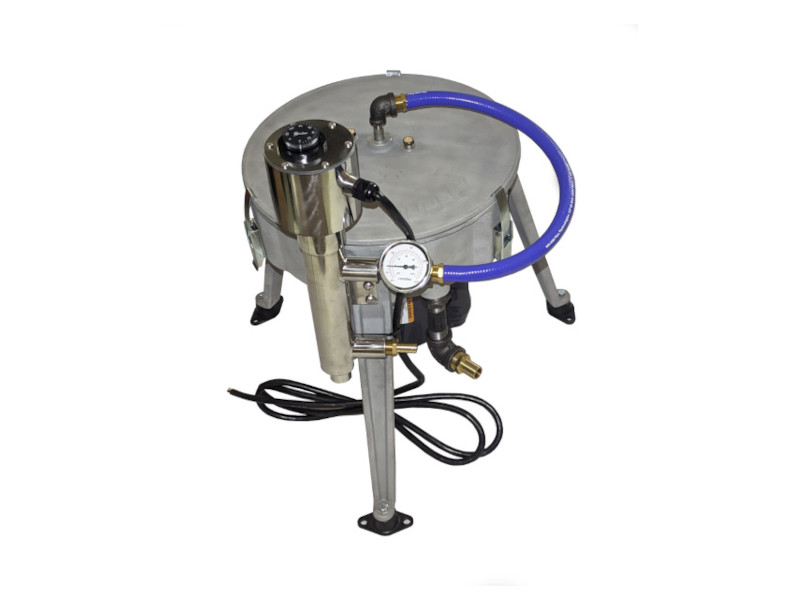
The Ultimate Force Centrifuge ships completely assembled with the exception of leg attachment, threading of fittings, and basic wiring. If you purchased an inline heater, you will need to install it. While every precaution has been taken to be sure your equipment arrives in perfect condition by packing with great care, handling and shipping is out of our control. Upon its arrival, please inspect the package and report any obvious damage to us right away.
*Tools necessary: 4 mm, 5 mm, 8 mm, and 3/16” Allen wrenches
SAFETY
As with all equipment, there are safety hazards involving oils, centrifuge use, static electricity, and piping of your unit and holding tank.
- Never operate the centrifuge without the cover securely attached.
- Never open a running centrifuge.
- Caution must be taken when centrifuging all flammable liquids.
- Ground all equipment before use to prevent static electricity.
It is the owners’ sole responsibility to decide what types of liquids are safe to centrifuge taking into consideration flammable vapors.
Unpacking
When unpacking your centrifuge pull the unit out of the box and set aside on carpet or padded area so you do not scratch the lid. Since the unit weighs approximately 65 lbs, caution should be used when removing it from the box. The packing peanuts are biodegradable and can be recycled or disposed in a sealed bag.
The Ultimate Force comes completely built except for the legs. The legs are installed on the unit in reverse for ease of shipping. Hold the top of the leg in place. While using a 4 mm Allen wrench, remove the two screws on each leg. Turn the legs around and reinstall. You should be able to hold the leg in place and hand tighten both bolts. When both bolts are in, using the Allen wrench, tighten both bolts again. When the three legs are reversed, they will extend out from the unit as pictured.
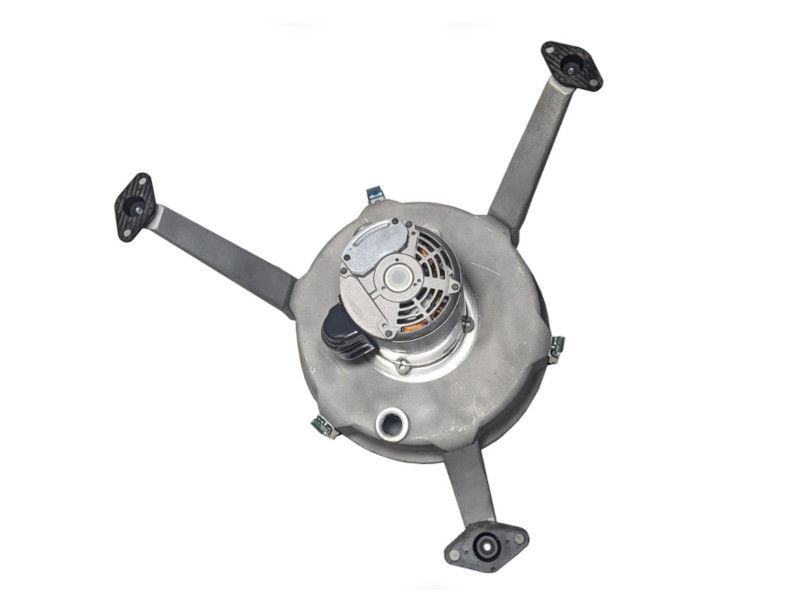

120V Wiring
Consult the Wiring Diagram on the motor
- Identify the color-coded wires on the motor. The most common colors are black, white, brown, red, and green
- Remove the black plastic cover on the side of the motor and install the wire clamp. Run your power cord through the connector.
- Match the black wire on the motor to position 2 as in the photo.
- On your 120V cord connect the Hot lead (Typically black) to position 1.
- Match the white wire on the motor to position 4.
- The white wire on the power cord is neutral, connect it to position 4 as well.
- Connect the ground wire to the ground screw on the motor.
- Use wire connectors or wire nuts to secure the connections.
- Reinstall the motor cover plate.
- Once all connections are made, turn on the power supply and test the motor.
240V Wiring
- The motor arrives with the three motor wires configured for 120V. The Brown, White, and Black wire will need to be disconnected.
- Install the wire connector onto the motor side and run your power cord through the connector.
- Match the Black and White wire to position 3.
- Connect the brown wire to position 5 or “P” which may be plastic.
- One of each hot wire from your power cord will be connected to a Hot Lead.
- Connect the ground from the power cord to the motor ground screw.
- Use wire connectors to install the wires to the proper position.
- Reinstall the motor plate cover.
- Turn on the power supply to test the motor.
*Wiring may vary depending on the motor your unit has installed. Always consult the wiring diagram on the motor prior to testing.*

Setting up Attachments
Set your unit on a flat surface below the contaminated oil feed and above the container being used to catch the clean oil.
The centrifuge comes with a vibration damper at the bottom of all three legs. Each damper has two holes which are to be used to mount your centrifuge to a hard surface.
Recommendation: Use a piece of plywood larger than your clean oil container. Mount the plywood to the container ensuring that the equipment and plywood will not move.
The clean oil and contaminated oil drain both come with all fittings included. The ¾” 90 and the ½ “ 90 will need their respective hose connection fittings installed as pictured below. You will need to purchase ¾” hose for the clean oil drain and ½” hose for the contaminated oil drain. The length of these hoses is dependent on the distance to your container.
Your supply container should have a gate valve to control the oil flow and a ball valve to be used as a shutoff valve. The flow will be dependent on temperature as well as the amount of oil in the container. As the temperature of the oil decreases, its viscosity increases, resulting in a slower flow. Additionally, as the oil level decreases within the container, the flow rate will also decrease.
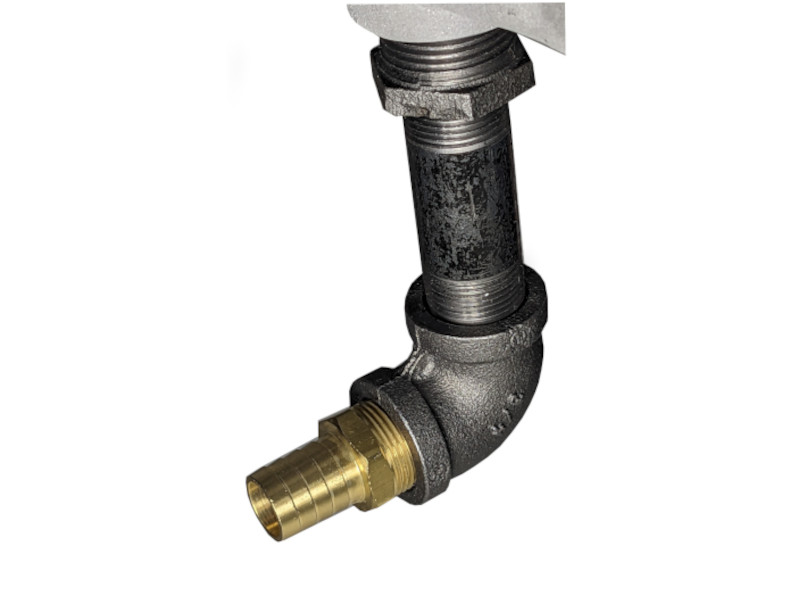
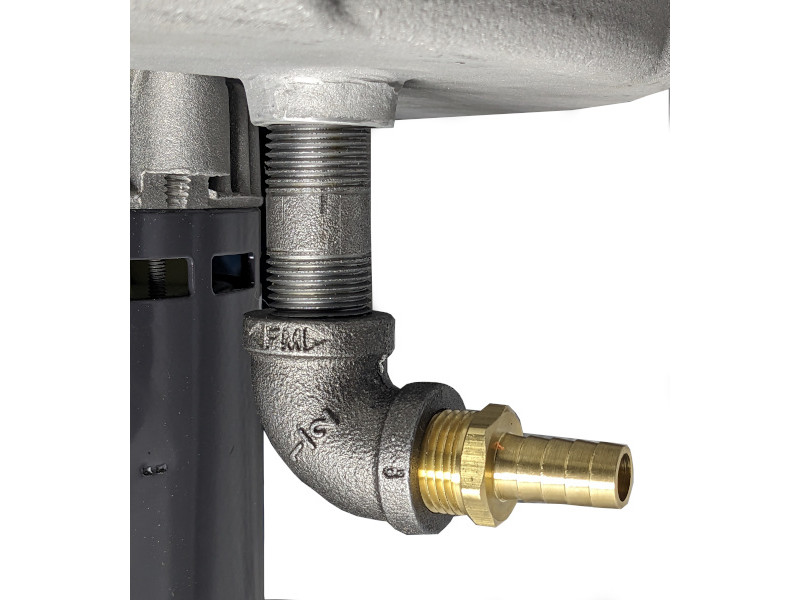
The clean oil drain is ¾” and needs to have fittings attached to the bottom of the centrifuge as in the picture above on the left. Clean oil will drain during operation and will cease draining upon shutdown.
The contaminant oil drain is ½”. Connect the fittings as pictured above on the right. The ½” hose from the contaminant side will only drain when shutting down the unit or when overflowing.
Feed to Centrifuge Attachment
The centrifuge comes with a 1/2” hose barb to introduce oil into it. Make the connections from your dirty oil container to include a gate valve for adjusting flow, a ball valve as an on/off flow valve, ending with a ½” hose barb. Connect the two hose barbs with ½” clear braided hose.
The oil entry fitting is a ½” hose barb, 90 and reduced down to a ¼” nipple. Install the ¼” nipple into the opening on top of the lid. (This will be a tight fit due to o-rings in the opening.) The lid has two breather caps for forced ventilation.
Heater Installation
When attaching the heater to the leg, first hand tighten one bolt through the bottom hole in the leg and into housing. Then attach the heater using the top hole. Place bolt through the top hole in the heater and centrifuge leg and into housing, then remove bottom bolt from leg and swing heater into place aligning bottom heater hole with leg hole. Bolt together and tighten both bolts.
From your dirty oil container, run your ½ “ hose to the bottom hose barb on the heater. Oil should always be introduced into the bottom of the heater and exit the top ensuring the heating element is always submerged. Connect the top hose barb with the 400 degree F. hose to the ½” hose barb on the lid of the centrifuge. NEVER use a hose from the heater feeding the centrifuge that is not rated for heat. Place a ¼ “ plug in the bottom of the heater. You are now set up and ready to turn your unit on.
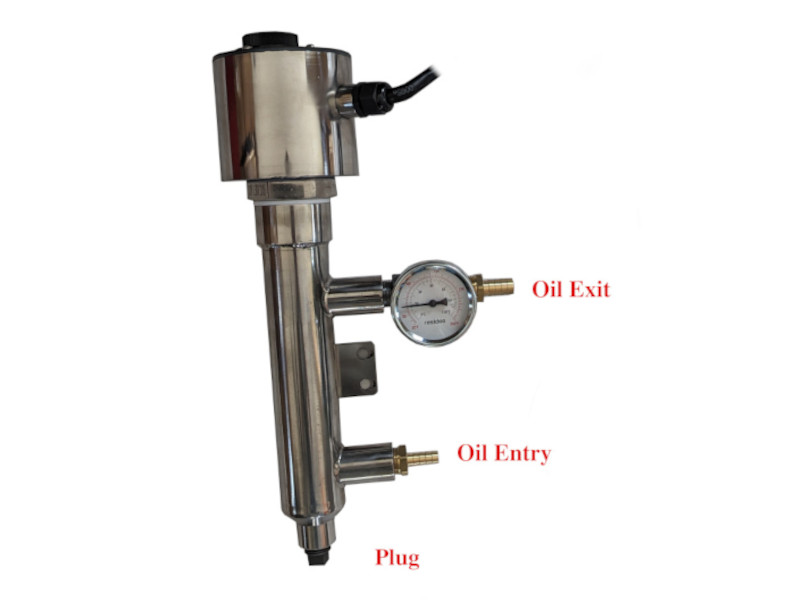

NOTE: Always turn the centrifuge on first (you want the centrifuge on before you open the oil flow), and turn the centrifuge off last (you want the centrifuge running until you turn the oil flow off).
Finishing the Centrifuge Run
After you have turned the centrifuge off, the bowl will quit spinning and will automatically drain out of the dirty oil drain. Do not remove the bowl from the unit until all oil has drained out. This can be verified by checking the dirty oil drain hose.
Bowl Removal
With an 8 mm allen wrench, hold the bowl steady and loosen the nut. Turn counterclockwise to loosen the nut. Pull the bowl out of the housing and place it in a container to catch any residual oil left in the bowl.
Bowl Lid Removal



With a 4 mm Allen wrench, hold the bowl steady, loosen and remove six screws.
After removal of screws, lift the lid and turn counterclockwise approximately 1 ½” to release the locking lid.
The bowl does not necessarily need to be removed for each cleaning, as the bowl itself is self draining. Once the bowl lid is removed, you can simply wipe out the bowl.
When replacing the bowl lid, ensure the seal is properly placed in the groove. Make sure all bolts are tight. Set bowl on bowl mount inside housing. Holding with one hand, tighten the nut.
Once your bowl has been installed, check all bolts on the bowl lid and the bowl mount for tightness. Make sure the seal for the housing is in the groove and install the housing lid. Lock down the three latches. You are now ready to start another run.
Disclaimer:
Every effort has been made to ensure the accuracy and completeness of the instruction manual. However, PA Biodiesel Supply, a Division of Wheeler Inspirations LLC, makes no warranties, expressed or implied, regarding errors or omissions, nor will it be held liable for the use of this product or any adapted version of this product, and assumes no legal liability nor responsibility for loss or damage resulting from use of the information contained herein.
 (833)-370-7590
(833)-370-7590 info@pabiodieselsupply.com
info@pabiodieselsupply.com